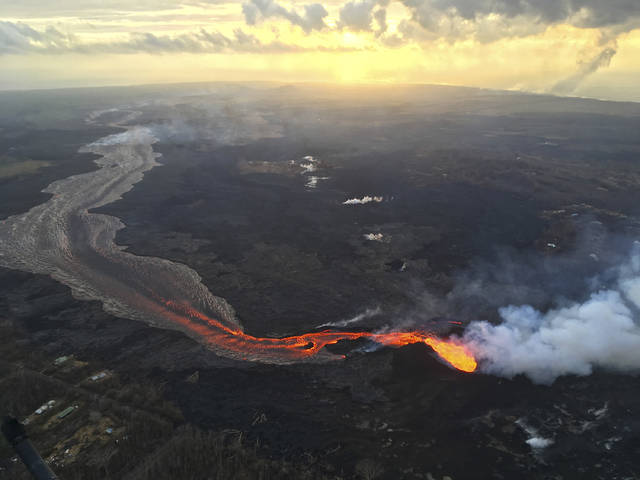Eruption sparks downturn for Big Isle hotels

U.S. Geological Survey
A sunrise is seen over the Kilauea volcano lower East Rift Zone, Tuesday. Tourism to parts of the island has plummeted since the volcano began erupting in a residential neighborhood and burning down homes in May.
Hawaii island’s hotel occupancy dropped in June by its largest amount in almost five years as the continuing eruption of Kilauea Volcano kept visitors away.
Hawaii island’s occupancy rate fell 6 percentage points to nearly 69 percent in June, according to data released by Tennessee-based STR, which tracks hotel performance across the state. It was the Big Island’s largest monthly occupancy decline since November 2013, when occupancy fell 11 percent to just over 54 percent.
“These numbers simply represent the huge disruption from the volcanic activity,” said Joseph Toy, president and CEO of Hospitality Advisors LLC. “It’s a huge impact.”
The 2013 decline was due to the lingering effect of the recession and reflected a drop in inventory supply due to financial difficulties or renovation-related closures, said Toy.
“This time around we don’t have the supply downturn,” so it is all due to the volcano, which began erupting May 3, said Toy.
As occupancy dropped, room rates are also inching lower.
Don't miss out on what's happening!
Stay in touch with breaking news, as it happens, conveniently in your email inbox. It's FREE!
In June the island’s average daily rate (ADR) fell 0.3 percent from June 2017 to just over $239, and the revenue per available room (RevPAR) dropped more than 8 percent to almost $164. RevPAR is the amount each property gets nightly for each room regardless of the room’s occupancy status. Monthly revenue was down to nearly $34 million, an almost 10 percent decline from June 2017 when the market brought in nearly $38 million in revenue.
Nick Minerd, STR communications director, reported that June was the first month this year that the company saw “a noticeable performance change in our Hawaii markets, specifically on the Big Island.”
To be sure, year to date through June, Hawaii island’s occupancy increased more than 2 percent to nearly 78 percent, ADR climbed almost 8 percent to nearly $272 and RevPAR was up almost 10 percent to more than $210. Monthly revenue grew almost 8 percent to nearly $266 million.
Hawaii island’s June hotel performance wasn’t entirely unexpected given the softening that had begun to emerge in the Hawaii Tourism Authority’s May visitor arrivals and spending data. While air service was up 8 percent to 796,178 visitors, cruise ships were down to 7,957 passengers, a nearly 43 percent dip from May 2017. In response to the eruption, Norwegian Cruise Line canceled the Pride of America’s port calls to Hilo and Kona during three voyages in May.
“Hawaii island’s hotel industry experienced heavy cancellations in May and June. Beyond June we are seeing less cancellations, but we’re still off our booking pace by 60 to 80 percent,” said Keith Vieira, principal of KV & Associates, Hospitality Consulting. “It’s alarming.”
Now the key question is how much of a disruption the Hawaii island dip is going to create for the state’s overall visitor industry, which during the first five months of this year, appeared headed toward breaking a benchmark of 10 million visitor arrivals in 2018.
Vieira said the continued closure of most of Hawai‘i Volcanoes National Park has had a dampening impact on Hawaii island that could extend across the isles.
“It’s the state’s No. 1 tourist attraction. At 2.6 million visitors a year, (the park) is bigger than Pearl Harbor,” Vieira said. “Until Hawaii island opens up some lava viewing areas, the people that were planning their trip around the park will continue canceling. If that was their reason to visit, they don’t want to re-book on another island where they can’t get that same experience. They’ll postpone their trip or go to another destination outside of Hawaii.”
Other islands steady
Hotel occupancy on other islands remained steady “without any signs of added demand coming from the lost business on the Big Island,” Minerd said.
Elizabeth Churchill, owner of the Churchill Group LLC, said it hasn’t helped that parts of Kauai and Oahu are still recovering from April floods and that the state’s second most popular visitor attraction, the USS Arizona Memorial, has been grappling with repairs.
“It’s pretty dramatic. It’s a shock to the system. This isn’t something that anyone was planning for,” Churchill said. “It’s a huge economic blow to the population.”
Oahu’s June occupancy grew less than 1 percent to 88 percent, while ADR rose nearly 3 percent to just over $243 and RevPAR grew 3 percent to more than $213. Revenue rose almost 4 percent to $191 million. Year to date through June, Oahu saw its occupancy rise nearly 2 percent to more than 84 percent, its ADR increased almost 2 percent to more than $233, and its RevPAR rose nearly 4 percent to nearly $197. Revenue rose 5 percent to nearly $1.1 billion.
Kauai’s June occupancy rose just over 1 percent to more than 77 percent, ADR increased more than 10 percent to $294 and RevPAR rose almost 12 percent to nearly $228. Revenue was up nearly 12 percent to nearly $31 million.
Maui’s June occupancy fell less than 1 percent to just over 77 percent, ADR rose more than 11 percent to more than $381 and RevPAR increased almost 11 percent to almost $295. Monthly revenue reached nearly $112 million, an 11 percent gain over June 2017.



